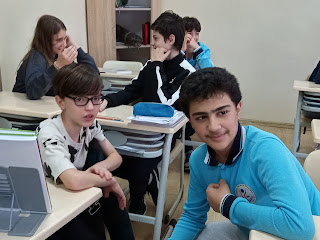 |
| Plenary session at Media Forum, Dec. 2023 |
Fulbright Update
Media Forum spotlights Russian disinformation tactics, goals
The big event of the media calendar year, the Moldova Media Forum, inspired and informed journalists and journalism educators from throughout the region last month.
For me, the highlight was an enlightening presentation on
Russian disinformation tactics and motives from Marian Voicu, a TV journalist
and fact checker (Verdica.ro) from Romania.
I also gave a presentation on peace journalism. More on
that in a moment.
Citing several studies and numerous examples, Voicu
talked about Russia’s disinformation goals in eastern Europe. These include
weakening Ukraine’s ability to sustain the war; convincing Romania to leave EU
and NATO; portraying Ukraine and NATO as American puppets; and spreading the
narrative that the West is trying to conquer Russia using Ukraine as a tool.
 |
| Marian Voicu, on Russian (and American) disinfo |
Interesting as well were studies cited by Voicu that show
that Russia aims to sew Euro-skepticism in eastern Europe by portraying the
west as pro-homosexual (and thus, against “traditional values”); by showing
that multiculturalism leads to societal decay; and by portraying democracies as
inherently weak and in need of strong leaders like Putin, who is portrayed as a
”real man,” according to Voicu, who gave the audience a great deal to think,
and worry, about.
Other sessions included one about the media market in
Moldova, where panelists from media houses and government regulators agreed on
the need for more sustainable funding, and more transparency when it comes to
funding sources. Another expertly moderated panel (by the Independent
Journalism Center’s Anastasia Nani) considered the problem of restoring trust
in media. Several speakers on this panel and others underscored the need for
more investigative journalism here in Moldova as a way to build credibility and
thus trust. The need for quality journalism that eschews “cutting and pasting”
from other sources and embraces strict ethics was also mentioned as a key to
building trust.
At the forum, the international media NGO Freedom House also released its 2023 report on freedom of information in Moldova. The index this year shows improvement over the past two years thanks to a new media law that brings access to information regulations up to international standards in Moldova. But the report notes that there’s still a long way to go here in terms of transparent information, including government websites, and access to information upon request.
 |
| Releasing the Freedom House report |
My presentation, Peace Journalism: Principles and
Applications, was well attended. About half were Russian speakers, meaning that
I had to navigate three languages even though I speak only two (English and
Romanian). At any rate, the audience was energetic and didn’t hesitate to ask
questions—qualities I always love. The most animated discussion was about peace
journalism and war, and how the principles I laid out might apply in practice.
The forum opened with speeches by Moldovan President Maia Sandu and US Ambassador Kent Logsdon about the importance of a vibrant, free press in Moldova.
Media Forum was sponsored by the Independent Journalism Center, Association of Independent Press in Moldova, and the Association of Electronic Press. I appreciate the invitation to participate in the event from the sponsors of my session, the UN Peacebuilding Fund and the offices in Moldova of the UN High Commissioner of Human Rights, the UN Development Program, and UN Women. I hope to continue collaborating with my UN colleagues in 2024.
See you next year!
I'm taking a little break now for the holidays. Peace Journalism Insights will return in January with new blogs about my misadventures in Moldova and elsewhere. May you have a joyous holiday season.


































